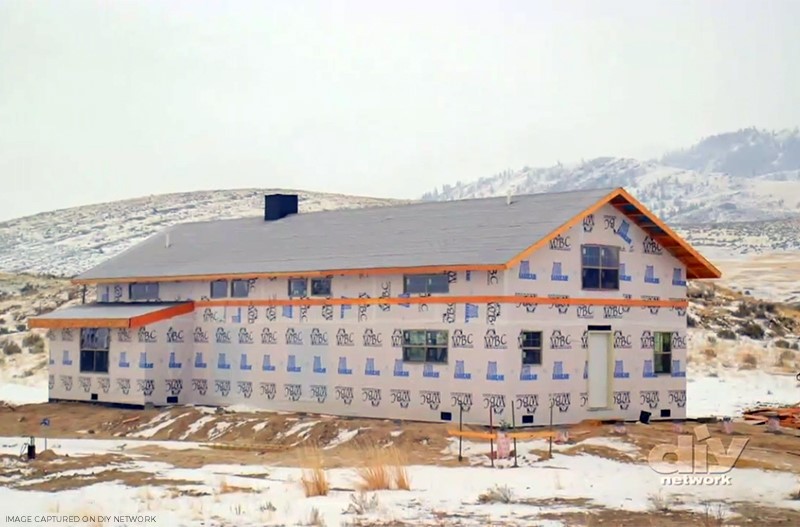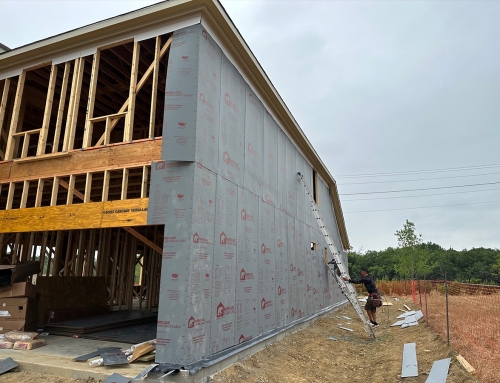The performance of a high-quality, vapor-permeable, house wrap is dependent on proper installation, careful handling, and limited exposure to UV radiation and outside elements. The goal of house wrap is to create an air and moisture barrier that also prevents moisture accumulation in the wall system. Ultimately, house wrap should boost a home’s energy efficiency and create a healthy, comfortable indoor environment. Common problems with house wrap can occur if not installed correctly. Further problems will occur if roughly handled or overly exposed to UV radiation and outside elements. All of these problems can diminish a house wrap’s resistance to air and moisture, along with its permeability.
IMPROPER HOUSE WRAP INSTALLATION
House wrap is often a synthetic and lightweight material that goes over a home’s sheathing and behind the siding. Correct installation of house wrap, according to manufacturer instructions, is critical to its performance. Incorrect installation of house wrap can affect a home’s ventilation and lead to a buildup of moisture in the wall cavities. Experienced and skilled house wrap installers avoid common problems with house wrap by following several key steps when installing house wrap.
Seal all seams with manufacturer recommended tape, including over the layers, the top and bottom edges, and the rough openings. It is also essential to seal the areas cut by subcontractors during the installation of the cladding.
House wrap is typically applied from the bottom of the building up, overlapping the horizontal joints by a minimum of six inches and the vertical joints by a minimum of twelve inches. Expand the house wrap over the footing top by a minimum of two inches. The house wrap should be fixed every 12 to 18 inches with specific stapling nails or nails designed to hold down house wrap material.
Installation of house wrap around the window and door openings involves a Y-cut from corner to corner in the openings. Then, the loose material is folded through the openings and fastened securely.
PROBLEMS WITH HOUSE WRAP DUE TO ROUGH HANDLING
Rough handling or long exposures to wind and construction debris can tear, rip, and cut the house wrap. These damaged areas of the house wrap will allow air and moisture to enter the wall system. It is critical to seal and repair all damage to the house wrap due to rough handling and overexposure to wind and construction debris.
HOUSE WRAP DAMAGE DUE TO OVEREXPOSURE TO UV RADIATION

(Photo credit: ecohome.net)
Overexposure of house wrap to the sun’s ultraviolet (UV) rays can discolor and photodegrade the house wrap. UV exposure can also cause the house wrap to loss tensile strength and water repellency. In some cases, this can happen quickly, depending on the house wrap’s ultraviolet (UV) rating. The UV-rating of a house wrap is the maximum time a house wrap can withstand exposure from the sun before becoming damaged.
USING BARRICADE HOUSE WRAP TO PREVENT COMMON HOUSE WRAP PROBLEMS
Barricade House Wrap is a high-quality, perforated, cross-woven polyolefin house wrap with superior durability and strength. Most importantly, Barricade® House Wrap combats common problems with house wrap due to improper installation, rough handling, overexposure to the wind, debris, and UV radiation.
EASY INSTALLATION WITH BARRICADE HOUSE WRAP
Barricade House Wrap is easy to install, which eliminates many of the installation problems associated with house wrap. Barricade House Wrap is semi-transparent and allows a clear view of the studs and sheathing surface during installation. Barricade House Wrap is also easy to handle, lightweight, and comes in many lengths and widths that can fit the requirements of any construction project. Damage to the house wrap during the installation process is reduced with Barricade House Wrap because it is easy to install and handle.
BARRICADE’S STRENGTH AND DURABILITY

Barricade House Wrap resists ripping and tearing during installation due to its superb tear strength. Also, Barricade House Wrap maintains its integrity against strong winds or weather events, cold temperatures, and UV-exposure. The durability and strength of Barricade House Wrap saves money and time by reducing the need for repairs during the construction process.
Tear Strength: Two tests measure a material’s strength or resistance to tearing: ASTM D5034 and ASTM D882. Barricade® House Wraps have a tear-resistant design with superior strength.
| House Wrap | Tensile Strength |
|---|---|
| Barricade Wrap | 63 lbs/inch MD 51 lbs/inch CD |
| Barricade Wrap Plus | 59 lbs/inch MD 51 lbs/inch CD |
| R-Wrap® | 32 lbs/inch MD 32 lbs/inch CD |
| Barricade Drainage Wrap | 24 lbs/inch MD 28 lbs/inch CD |
| WeatherTrek® | 27 lbs/inch MD 24 lbs/inch CD |
UV Inhibitors: Barricade House Wraps can withstand extensive UV-exposure without damage occurring.
| House Wrap | UV Exposure Rating |
|---|---|
| Barricade Wrap | 12 Months |
| Barricade Wrap Plus | 9 Months |
| R-Wrap® | 4 Months |
| Barricade Drainage Wrap | 4 Months |
| WeatherTrek® | 12 Months |
Temperature resistance: Barricade House Wraps are cold resistant. AC38 Section 3.3.4: (Cold Mandrel Bend Test) ensures the house wrap won’t crack at low temperatures.
The performance of a high-quality vapor-permeable, house wrap is often diminished by several common problems: improper installation, rough handling, and overexposure to UV radiation and outside elements. All of these problems can reduce the house wraps resistance to air and moisture, along with its permeability. Barricade House Wraps combat these problems due to their superb strength and durability and ease of installation.







